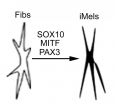(Press-News.org) PHILADELPHIA - As the main component of connective tissue in the body, fibroblasts are the most common type of cell. Taking advantage of that ready availability, scientists from the Perelman School of Medicine at the University of Pennsylvania, the Wistar Institute, Boston University School of Medicine, and New Jersey Institute of Technology have discovered a way to repurpose fibroblasts into functional melanocytes, the body's pigment-producing cells. The technique has immediate and important implications for developing new cell-based treatments for skin diseases such as vitiligo, as well as new screening strategies for melanoma. The work was published this week in Nature Communications.
The new technique cuts out a cellular middleman. Study senior author Xiaowei "George" Xu, MD, PhD, an associate professor of Pathology and Laboratory Medicine, explains, "Through direct reprogramming, we do not have to go through the pluripotent stem cell stage, but directly convert fibroblasts to melanocytes. So these cells do not have tumorigenicity."
Changing a cell from one type to another is hardly unusual. Nature does it all the time, most notably as cells divide and differentiate themselves into various types as an organism grows from an embryo into a fully-functional being. With stem cell therapies, medicine is learning how to tap into such cell specialization for new clinical treatments. But controlling and directing the process is challenging. It is difficult to identify the specific transcription factors needed to create a desired cell type. Also, the necessary process of first changing a cell into an induced pluripotent stem cell (iPSC) capable of differentiation, and then into the desired type, can inadvertently create tumors.
Xu and his colleagues began by conducting an extensive literature search to identify 10 specific cell transcription factors important for melanocyte development. They then performed a transcription factor screening assay and found three transcription factors out of those 10 that are required for melanocytes: SOX10, MITF, and PAX3, a combination dubbed SMP3.
"We did a huge amount of work," says Xu. "We eliminated all the combinations of the other transcription factors and found that these three are essential."
The researchers first tested the SMP3 combination in mouse embryonic fibroblasts, which then quickly displayed melanocytic markers. Their next step used a human-derived SMP3 combination in human fetal dermal cells, and again melanocytes (human-induced melanocytes, or hiMels) rapidly appeared. Further testing confirmed that these hiMels indeed functioned as normal melanocytes, not only in cell culture but also in whole animals, using a hair-patch assay, in which the hiMels generated melanin pigment. The hiMels proved to be functionally identical in every respect to normal melanocytes.
Xu and his colleagues anticipate using their new technique in the treatment of a wide variety of skin diseases, particularly those such as vitiligo for which cell-based therapies are the best and most efficient approach.
The method could also provide a new way to study melanoma. By generating melanocytes from the fibroblasts of melanoma patients, Xu explains, "we can screen not only to find why these patients easily develop melanoma, but possibly use their cells to screen for small compounds that can prevent melanoma from happening."
Perhaps most significantly, say the researchers, is the far greater number of fibroblasts available in the body for reprogramming compared to tissue-specific adult stem cells, which makes this new technique well-suited for other cell-based treatments.
INFORMATION:
The research was supported by the National Institutes of Health (R01-AR054593, P30-AR057217)
Penn Medicine is one of the world's leading academic medical centers, dedicated to the related missions of medical education, biomedical research, and excellence in patient care. Penn Medicine consists of the Raymond and Ruth Perelman School of Medicine at the University of Pennsylvania (founded in 1765 as the nation's first medical school) and the University of Pennsylvania Health System, which together form a $4.3 billion enterprise.
The Perelman School of Medicine has been ranked among the top five medical schools in the United States for the past 17 years, according to U.S. News & World Report's survey of research-oriented medical schools. The School is consistently among the nation's top recipients of funding from the National Institutes of Health, with $392 million awarded in the 2013 fiscal year.
The University of Pennsylvania Health System's patient care facilities include: The Hospital of the University of Pennsylvania -- recognized as one of the nation's top "Honor Roll" hospitals by U.S. News & World Report; Penn Presbyterian Medical Center; Chester County Hospital; Penn Wissahickon Hospice; and Pennsylvania Hospital -- the nation's first hospital, founded in 1751. Additional affiliated inpatient care facilities and services throughout the Philadelphia region include Chestnut Hill Hospital and Good Shepherd Penn Partners, a partnership between Good Shepherd Rehabilitation Network and Penn Medicine.
Penn Medicine is committed to improving lives and health through a variety of community-based programs and activities. In fiscal year 2013, Penn Medicine provided $814 million to benefit our community.
Two studies published in the January issue of Anesthesiology, the official medical journal of the American Society of Anesthesiologists® (ASA®), shed new light on the prevalence of transfusion-related acute lung injury (TRALI) and transfusion-associated circulatory overload (TACO), the number one and two leading causes of blood transfusion-related deaths in the United States. According to researchers, postoperative TRALI is significantly underreported and more common than previously thought, with an overall rate of 1.4 percent. While the rate of TACO was found ...
Alzheimer's disease (AD) is the most common form of dementia and is characterized by the formation of β-amyloid plaques throughout the brain. Proteins known as chemokines regulate inflammation and the immune response. In both patients with AD and mouse AD models, the chemokine CXCL10 is found in high concentrations in the brain and may contribute to AD. A new study in the Journal of Clinical Investigation indicates that activation of the CXCL10 receptor, CXCR3, contributes to AD pathology. Using a murine model of AD, Michael Heneka and colleagues at the University ...
Nonalcoholic fatty liver disease (NAFLD) is the most common liver disorder and affects approximately 1 billion people worldwide. It is not clear how this disease develops, but recent studies suggest that the bacterial population in the gut influences NAFLD. A new study in the Journal of Clinical Investigation provides a link between molecular signaling pathways in the gut, the intestinal microbiome, and development of NAFLD. Frank Gonzalez and colleagues at the National Cancer Institute found that disruption of the gut microflora prevented development of NAFLD in mice fed ...
A pregnant woman in Africa who has contracted Ebola is likely to suffer with a spontaneous abortion, pregnancy-related hemorrhage, or the death of her newborn. Although the risk of caring for a pregnant woman with Ebola in the United States may be rare, the Association of Women's Health, Obstetric and Neonatal Nurses (AWHONN) has published a practice brief in its Journal of Obstetric, Gynecologic, & Neonatal Nursing to guide nursing care for pregnant women and newborns.
"Nurses play a vital role in caring for patients with Ebola," said Dr. Debra Bingham, who is Vice President ...
Emotions are complicated and never more so than in the realm of the scientific, where commonly accepted definitions are lacking.
In a paper published in the journal Qualitative Inquiry, UC Santa Barbara's Thomas Scheff examines the basic emotions of grief, fear/anxiety, anger, shame and pride as they appear in scientific literature in an attempt to take a first step in defining them. "Emotion terms, especially in English, are wildly ambiguous," Scheff writes in the paper's introduction.
An emeritus professor of sociology at UCSB, Scheff set out to explore why the language ...
VCU Massey Cancer Center physician-researcher Charles E. Geyer, Jr., M.D., was the National Protocol Officer for one component of a large national study involving two National Cancer Institute (NCI)-supported clinical trials that demonstrated that trastuzumab significantly improves the long-term survival of HER-2 positive breast cancer patients. The combined study was designed to determine the long-term safety and efficacy of the drug trastuzumab, which is commonly known as Herceptin and is primarily used alongside chemotherapy to treat HER2-positive breast cancer. The ...
Driving vehicles that use electricity from renewable energy instead of gasoline could reduce the resulting deaths due to air pollution by 70 percent. This finding comes from a new life cycle analysis of conventional and alternative vehicles and their air pollution-related public health impacts, published Monday, Dec. 15, 2014, in the Proceedings of the National Academy of Sciences.
The study also shows that switching to vehicles powered by electricity made using natural gas yields large health benefits. Conversely, vehicles running on corn ethanol or vehicles powered ...
NEW YORK, NY (December 15, 2014)--Researchers at Columbia University Medical Center have found that, in addition to gluten, the immune systems of patients with celiac disease react to specific types of non-gluten protein in wheat. The results were reported online in the Journal of Proteome Research.
Celiac disease, an autoimmune disorder that affects about 1 percent of the U.S. population, is triggered by the ingestion of wheat and related cereals in genetically susceptible individuals. The immune response results in inflammation and tissue damage in the small intestine, ...
VIDEO:
This animation (from March 2014) portrays the changes occurring in the surface elevation of the Greenland Ice Sheet since 2003 in three drainage areas: the southeast, the northeast and the...
Click here for more information.
For years NASA has tracked changes in the massive Greenland Ice Sheet. This week scientists using NASA data released the most detailed picture ever of how the ice sheet moves toward the sea and new insights into the hidden plumbing of melt water ...
ORANGE, Calif. - Researchers in Chapman University's Food Science Program and their collaborators at University of Washington have just published a study on the presence of Salmonella and E. coli on certain herbs sold at farmers' markets. The study focused on farmers' markets in Los Angeles and Orange counties in California, as well as in the Seattle, Washington, area. Specifically tested were samples of the herbs cilantro, basil and parsley. Of the 133 samples tested from 13 farmers' markets, 24.1 percent tested positive for E. coli and one sample tested positive for Salmonella.
"While ...


